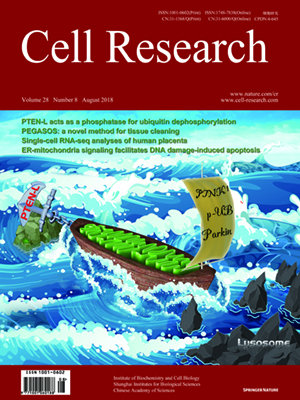
Volume 28, No 8, Aug 2018
ISSN: 1001-0602
EISSN: 1748-7838 2018
impact factor 17.848*
(Clarivate Analytics, 2019)
Volume 28 Issue 8, August 2018: 803-818 | Open Access
ORIGINAL ARTICLES
Tissue clearing of both hard and soft tissue organs with the PEGASOS method
Dian Jing 1,2, Shiwen Zhang 2,1, Wenjing Luo 1, Xiaofei Gao 3, Yi Men 1, Chi Ma 1
, Xiaohua Liu 1, Yating Yi 1,2, Abhijit Bugde 4,Bo O. Zhou 5, Zhihe Zhao 2, Quan Yuan 2, Jian Q. Feng 1, Liang Gao 6, Woo-Ping Ge 3 and Hu Zhao 1
1Department of Restorative Sciences, School of Dentistry, Texas A&M University, Dallas, TX 75246, USA; 2State Key Laboratory of Oral Diseases, National Clinical Research Center
for Oral Diseases, West China Hospital of Stomatology, Sichuan University, Chengdu 610041, China; 3Children’s Research Institute, Departments of Pediatrics, Neuroscience, Neurology and Neurotherapeutics, UT Southwestern Medical Center, Dallas, TX 75390, USA; 4Live Cell Imaging Core Facility, UT Southwestern Medical Center, Dallas, TX 75390,USA; 5State Key Laboratory of Cell Biology, Shanghai Institute of Biochemistry and Cell Biology, Chinese Academy of Sciences, University of Chinese Academy of Sciences, 320 Yueyang Road, Shanghai 200031, China and 6Intelligent Imaging Innovations (3i) Inc., 3509 Ringsby Court, Denver, CO 80216, USA
These authors contributed equally: Dian Jing, Shiwen Zhang, Wenjing Luo
Correspondence: Correspondence: Hu Zhao (hzhao@tamhsc.edu)
Tissue clearing technique enables visualization of opaque organs and tissues in 3-dimensions (3-D) by turning tissue transparent. Current tissue clearing methods are restricted by limited types of tissues that can be cleared with each individual protocol, which inevitably led to the presence of blind-spots within whole body or body parts imaging. Hard tissues including bones and teeth are still the most difficult organs to be cleared. In addition, loss of endogenous fluorescence remains a major concern for solvent-based clearing methods. Here, we developed a polyethylene glycol (PEG)-associated solvent system (PEGASOS), which rendered nearly all types of tissues transparent and preserved endogenous fluorescence. Bones and teeth could be turned nearly invisible after clearing. The PEGASOS method turned the whole adult mouse body transparent and we were able to image an adult mouse head composed of bones, teeth, brain, muscles, and other tissues with no blind areas. Hard tissue transparency enabled us to reconstruct intact mandible, teeth, femur, or knee joint in 3-D. In addition, we managed to image intact mouse brain at sub-cellular resolution and to trace individual neurons and axons over a long distance. We also visualized dorsal root ganglions directly through vertebrae. Finally, we revealed the distribution pattern of neural network in 3-D within the marrow space of long bone. These results suggest that the PEGASOS method is a useful tool for general biomedical research.
https://doi.org/10.1038/s41422-018-0049-z
FULL TEXT | PDF
Browse 2268


